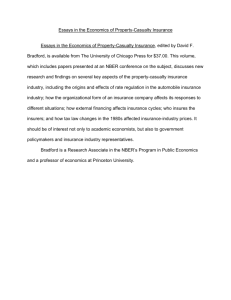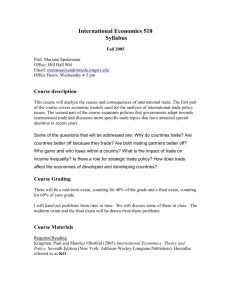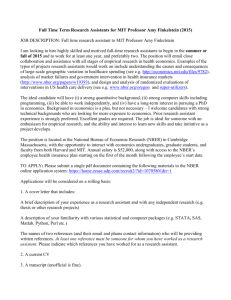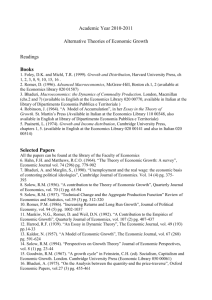International Trade Policy
advertisement
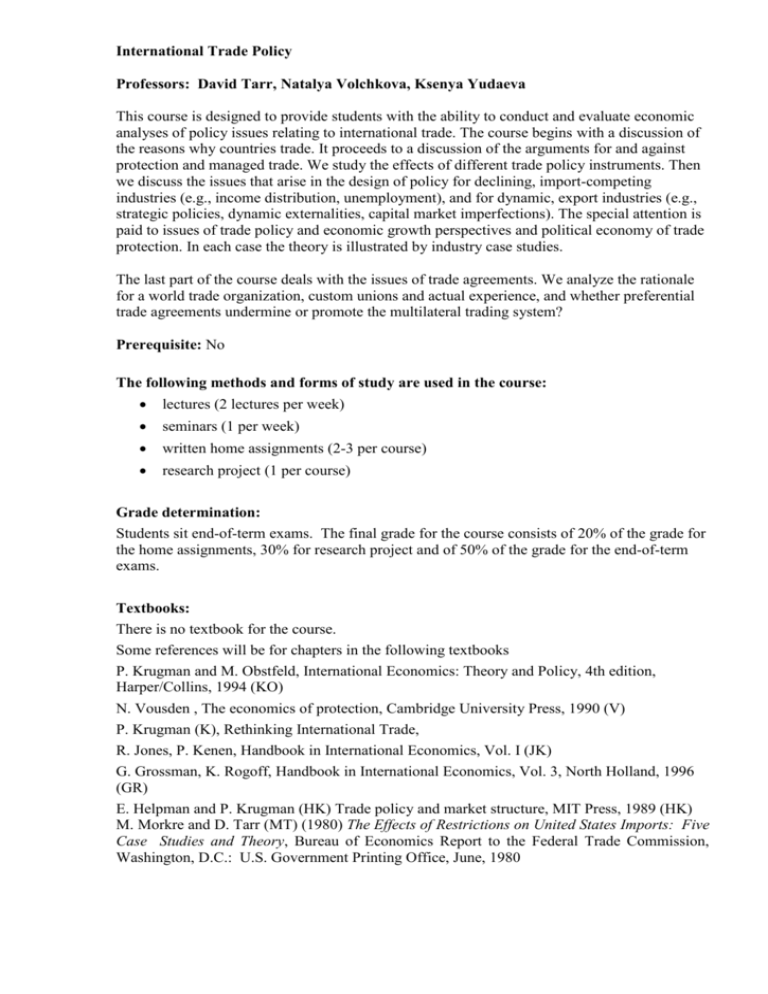
International Trade Policy Professors: David Tarr, Natalya Volchkova, Ksenya Yudaeva This course is designed to provide students with the ability to conduct and evaluate economic analyses of policy issues relating to international trade. The course begins with a discussion of the reasons why countries trade. It proceeds to a discussion of the arguments for and against protection and managed trade. We study the effects of different trade policy instruments. Then we discuss the issues that arise in the design of policy for declining, import-competing industries (e.g., income distribution, unemployment), and for dynamic, export industries (e.g., strategic policies, dynamic externalities, capital market imperfections). The special attention is paid to issues of trade policy and economic growth perspectives and political economy of trade protection. In each case the theory is illustrated by industry case studies. The last part of the course deals with the issues of trade agreements. We analyze the rationale for a world trade organization, custom unions and actual experience, and whether preferential trade agreements undermine or promote the multilateral trading system? Prerequisite: No The following methods and forms of study are used in the course: lectures (2 lectures per week) seminars (1 per week) written home assignments (2-3 per course) research project (1 per course) Grade determination: Students sit end-of-term exams. The final grade for the course consists of 20% of the grade for the home assignments, 30% for research project and of 50% of the grade for the end-of-term exams. Textbooks: There is no textbook for the course. Some references will be for chapters in the following textbooks P. Krugman and M. Obstfeld, International Economics: Theory and Policy, 4th edition, Harper/Collins, 1994 (KO) N. Vousden , The economics of protection, Cambridge University Press, 1990 (V) P. Krugman (K), Rethinking International Trade, R. Jones, P. Kenen, Handbook in International Economics, Vol. I (JK) G. Grossman, K. Rogoff, Handbook in International Economics, Vol. 3, North Holland, 1996 (GR) E. Helpman and P. Krugman (HK) Trade policy and market structure, MIT Press, 1989 (HK) M. Morkre and D. Tarr (MT) (1980) The Effects of Restrictions on United States Imports: Five Case Studies and Theory, Bureau of Economics Report to the Federal Trade Commission, Washington, D.C.: U.S. Government Printing Office, June, 1980 Course outline Part I. Why do countries trade? Lecture 1. (NV) 1. Dynamics of trade flows. Regional distribution of trade flows. 2. Russia and international specialisation. 3. Why do countries trade? Overview of classical models. A. Estevadeordal et al. “The Rise and Fall of World Trade, 1870-1939” NBER WP 9318 KO, chs. 2-5 R. Feenstra, “Integration of trade and disintegration of production in the global economy”, Journal of Economic Perspective, Fall 1998, pp. 31-50 P. Krugman et al., 1995, “Growing world trade: causes and consequences”, Brookings Papers on Economic Activities, Vol. 1995, # 1 P. Krugman, 1996, “The Adam Smith address: What difference does globalization make? Lecture 2. (NV) 1. Why do countries trade? Overview of classical models. 2. Ricardo and comparative advantage. 3. Heckscher-Ohlin (2x2x2) model. 4. Who wins, who loses because of international trade: specific factors model. KO, ch. 3-4 A. Deardoff, “The general validity of the law of comparative advantage”, JPE, 1980, 941-957. A. Deardoff, “The general validity of the Heckscher-Ohlin model”, AER, 1982, 683-694. E. Helpman, “The factor content of foreign trade”, EJ, 1984, 84-94 B. Balassa, 1963, “An empirical demonstration of classical comparative cost theory”, The Review of Economics and Statistics, Vol. 45, Is. 3 D. Trefler, 1993, International Factor Price Differences: Leontief was Right!”, The Journal of Political Economy, Vol. 101, Is. 6 D. Trefler, 1995, “The Case of the Missing Trade and Other Mysteries”, The American Economic Review, Vol. 85, No. 5 Lecture 3. (NV) 1. Standard trade model. Terms of trade and welfare. Comparative static analyses: transfer problem, immiserizing growth, tariffs and subsidies. 2. Nontradables: Dornbush-Fischer-Samuelson model. KO, ch. 5 Bhagwati J., Brecher R., Hatta T., 1983, “The Generalized Theory of Transfers and Welfare”, American Economic Review, 73 Metzler, 1949, “Tariffs, the Terms of Trade, and the Distribution of National Income”, Journal of Political Economy, 57 Dornbusch, R., Fischer, S., Samuelson, P.A, 1977, “Comparative Advantage, Trade, and Payments in a Ricardian Model with a Continuum of Goods”, The American Economic Review, Vol. 67, N. 5 The positive and normative theory of trade protection Lecture 4. (KY) 1. Instruments of trade policy. Tariffs and quantitative restrictions (quotas, local content schemes, export subsidies). How to measure losses from quantitative restrictions. Equivalent tariff. 2. Quotas vs. Tariffs: nonequivalence. Dynamic nonequivalence. The case of uncertain economic parameters. 3. Export taxes and Lerner symmetry theorem. 4. Preferential government procurement policy. 5. The consequences of trade restrictions for small open economy. 6. Tariffs and non-economic objectives. Second-best vs. first best economic policy. 7. Large economy case and optimum tariff. V, pp. 25-59 Lecture 5. (DT) 1. Theory of the costs of trade restrictions 2. How to measure trade restrictions 3. Assesment of gains and losses of trade liberalization MT, Ch. 2 Lecture 6. (DT) 1. 2. 3. 4. 5. Costs of Trade Restrictions under CRTS—applications Costs of Tariffs - Textile tariffs Costs of trigger prices—US trigger price case Costs of VERS—US auto case Costs of restrictive licenses or quotas—Case of Hungarian licensing of imports MT Tarr, David and Morris Morkre (1984), Aggregate Costs to the United States of Tariffs and Quotas on Imports," General Tariff Cuts and Removal of Quotas on Automobiles, Steel, Sugar, and Textiles, Bureau of Economics Report to the Federal Trade Commission, U.S. Government Printing Office, December. The United States Steel Industry and Its International Rivals: Trends and Factors Determining International Competitiveness, Bureau of Economics Report to the Federal Trade Commission, Washington, D.C., U.S. Government Printing Office, November 1977. (With R. Duke, R. Johnson, H. Mueller, P.D. Qualls and C. Roush.) Morkre, Morris and David Tarr (1995), "Reforming Hungarian Agricultural Trade Policy: A Quantitative Evaluation," Weltwirtschaftliches Archiv Band 131, Heft 1, 106-131. Lecture 7. (DT) 1. Adjustment costs of trade liberalization Steve Matusz and David Tarr, “Adjusting to Trade Liberalization,” in Anne O. Krueger (ed.), Economic Policy Reform: The Second Stage, Chicago: The University of Chicago Press, 2000.. Lecture 8. (DT) 1. Tariff uniformity--arguments for and against "On the Design of Tariff Policy: Arguments for and Against Uniform Tariffs,” in B. Hoekman, A. Mattoo and P. English (eds.), Development, Trade and the WTO: A Handbook, Washington: World Bank, 2002. Lecture 9. (DT) 1. Natural gas pricing in Russia Peter Thomson and David Tarr, "The Merits of Dual Pricing of Russian Natural Gas," The World Economy, Vol. 27, Issue 8. August 2004, 1173-1194 Lecture 10. (DT) 1. Exchange rate overvaluation and trade Howard Shatz and David Tarr, "Exchange Rate Management and Trade Protection," in B. Hoekman, A. Mattoo and P. English (eds.), Development, Trade and the WTO: A Handbook, Washington: World Bank, 2002.. David Tarr, "Second-Best Foreign Exchange Policy in the Presence of Domestic Price Controls and Export Subsidies," The World Bank Economic Review, May 1990. Lecture 11. (KY) 1. 2. 3. 4. Internal and external economies of scale. Intra-industry trade: reasons and consequences. Dumping. Factor mobility and its consequences. KO, ch. 6 E. Leamer, J. Levinsohn, “International trade theory: the evidence”, в GR E. Helpman, “The structure of foreign trade”, Journal of Economic Perspective, Spring 1999, 121- 144. Lecture 12. (KY) 1. Administered protection: antidumping, compensation and protectionist measures. V, pp. 38-43, 60-74 HK, pp. 27-38, 56-58 T.J. Prusa, “On the Spread and Impact of Antidumping”, NBER Working Paper No. 7404, 1999 R. Feenstra, “How costly is protectionism”, Journal of Economic Perspectives, Summer 1992 Bloningen, Prusa “Antidumping”, NBER 8398. Brown, Deardorff and Stern (2003) "Developing Countries' Stake in the Doha Round,". http://www.fordschool.umich.edu/rsie/workingpapers/wp.html Jesper, Rutherford and Tarr “”Economy-Wide and Sector Effects of Russia’s Accession to the WTO,” paper prepared for the Allied Social Science Meetings, Washington DC, January 2-5. Irwin “Causing problems? The WTO review of insury attribution”, NBER 9815. Lecture 13. (KY) 1. Dynamic comparative advantage 2. Infant industry arguments 3. Dynamic externalities and economies of scale Krugman (1997) “The Narrow movong band, the Dutch Disease, and the competitive consequences of Mrs. Thatcher: Notes on trade in the presence of dynamic scale economies” R.Baldwin, "The Case Against Infant Industry Protection," Journal of Political Economy, May 1969 D. Irwin, "Did Late Nineteenth Century Tariffs Promote Infant Industries? Evidence from the Tinplate Industry," NBER Working Paper No.6835, December 1998. Lecture 14. (KY) 1. Dynamic effects of trade liberalization 2. Trade policy and growth 3. Openness and income distribution Rigobon+Rodrik RULE OF LAW, DEMOCRACY, OPENNESS, AND INCOME: ESTIMATING THE INTERRELATIONSHIPS 2004; NBER 10750 Lopes-Cordova, Meissner THE GLOBALIZATION OF TRADE AND DEMOCRACY, 18702000, 2005; NBER 11117 Bolaky+Freund “Trade, regulation and growth”, 2004, World Bank. Wacziarg+Welch “Trade liberalization and growth: New evidence.” 2003 NBER 10152 Sachs and Warner (1995): Economic Reform and the Process of Global Integration” Edwards (1998) “Openness, Productivity and Growth: What Do We Really Know?” Rodriques, Rodrik (1999) “Trade policy and economic growth: a skeptic’s guide to the crossnational evidence” Dollar and Kraay (2001) “Trade, growth and poverty” Birdsall and Hamoudi (2002) “Commodity dependence, trade and growth: when openness is not enough” Milanovic (2002) “Can we discern the effect of globalization on income distribution? Evidence from household budget surveys”. Part II. Theory of Economic Integration Lecture 1. (KY) 1. 2. 3. 4. Traditional Customs Union Theory Trade Creation and Trade Diversion Conditions that maximize the chance that a CU is beneficial Empirical estimation of PTA effects on welfare. R. Baldwin and A. Venables, "Regional Economic Integration," in G. Grossman and K.Rogoff, eds, Handbook of International Economics, vol.3, North Holland, 1996. K. Bagwell and R.W. Staiger, “An Economic Theory of the GATT”, American Economic Review, 1999 M. Kemp and H. Wan, “An Elementary Proposition Concerning the Formation of Custom Unions”, Journal of International Economics, 1976 M. Kemp and H. Wan, “The Comparison of Second-Best Equilibria, The Case of Custom Unions”, Journal of International Economics, 1981 Dee, Gali “ The Trade and Investment Effects of Preferential Trading Agreements”, 2003, NBER 10160. Lecture 2. (KY) 1. 2. 3. 4. Economic validation of main principles of WTO. Problems of multilateral trade agreements Regional versus multilateral trade unions Political economy of integration Helpman, E., 1995, “Politics and Trade Policy”, NBER Working Paper 5309 Bagwell, K., Staiger, R. W., 2004, “Enforcement, Private Political Pressure And The GATT/WTO Escape Clause”, NBER Working Paper 10987 Horn, H., Mavroidis P. C., 2001, “Economic and Legal Aspects of the Most Favoured Nation Clause”, CEPR Discussion Paper Series 2859 P. Krugman, "Is Bilateralism Bad?", in E. Helpman and A. Razin, International Trade and Trade Policy, The MIT Press, 1991. P. Krugman, “Regionalism Versus Multilateralism: Analytical Notes”в J. De Melo and A. Panagariya eds., New Dimensions in Regional Integration, Cambridge University Press, 1993 The Political Economy of Protection Lectures 3-4-5. (NV) 1. 2. 3. 4. 5. 6. Endogenous protection Direct majority voting: Hecksher-Ohlin and Specific Factor models setups. Pressure groups: features. Consumers vs. Producers pressure groups. Grossman&Helpman’94: Protection for sale Grossman&Helpman’05: Protectionist Bias Empirical estimations of political economy theories V, pp. 177-203 KO, ch. 9 D.Rodrik, “The political Economy of Trade Policy”, в GR Helpman, E., 1995, “Politics and Trade Policy”, NBER Working Paper 5309 P. Goldberg and G. Maggi, "Protection for Sale: An Empirical Investigation," American Economic Review, Dec. 1999, стр. 1135-1155. Trefler (1993) “Trade liberalization and the theory of endogenous protection: an econometric study of US import policy”, Journal of Political Economy, Vol. 101, N. 1 Gawande and Bandyopadhyay (2000) “Is protection for sale? Evidence on the GrossmanHelpman theory of endogenous protection”, Review of Economics and Statistics 82 (1) Grossman, Gene M. and Elhanan Helpman, “Protection for Sale,” American Economic Review, 1994. Grossman, Gene M. and Elhanan Helpman, “The Politics of Free Trade Agreements,” American Economic Review, 1995. Helpman, Elhanan, “Politics and Trade Policy,” in David M. Kreps and Kenneth F. Wallis (eds.), Advances in Economics and Econometrics: Theory and Applications (New York and Cambridge: Cambridge University Press), 1997, pp. 19-45. Grossman, Gene M. and Elhanan Helpman, “A Protectionist Bias in Majoritarian Politics,” 2005 Mitra, Daveshin, Dimitrios D. Thomakos and Mehmet A. Ulubasoglu, “‘Protection for Sale’ in a Developing Country: Democracy versus Dictatorship,” Review of Economics and Statistics, 2002. Lecture 6. (NV) 1. Natural resource curse: reasons and consequencies 2. Application to Russia Auty, R.M. (2001), ‘The Political Economy of Resource-Driven Growth’, European Economic Review 45, p. 839-846 Bravo-Ortega, C. and De Gregorio, J. (2003), ‘The Relative Richness of the Poor? Natural Resources, Human Capital and Economic Growth’, World Bank Working Paper Hutchison, M.M. (1994), ‘Manufacturing Sector Resiliency to Energy Booms: Empirical Evidence from Norway, the Netherlands, and the United Kingdom’, Oxford Economic Papers, New Series, 46 (2), p. 311-329 Sachs, J. and A. Warner (1995),’Natural Resource Abundance and Economic Growth’, National Bureau of Economic Research working paper 5398, Cambridge, MA. Sachs, J. and A. Warner (1999b), ‘The Curse of Natural Resources’, European Economic Review 45, p. 827-838 Sala-i-Martin, X. and Subramanian, A, (2003), ‘Addressing the Natural Resource Curse: An Illustration from Nigeria’, IMF Working Paper 03/139 Wijnbergen, S. (1984a), ‘The "Dutch Disease": A Disease After All?’, The Economic Journal 94, p. 41-55 Regionalism Lectures 7-8-9. (DT) 1. 2. 3. 4. 5. 6. 7. 8. Trade Diversion and Trade Creation—in a homogeneous product model Trade Diversion and Trade Creation—in a heterogeneous product model Comparison with Morocco-EU and Turkey-EU FTAs Deep Integration Practice and CGE assessment of regionalism Additive (or “Competitive”)Regionalism Poverty impacts of regionalism Customs Unions in the CIS Ferdinand Bakoup and David Tarr, “The Economic Effects of Integration in the Central African Economic and Monetary Community: Some General Equilibrium Estimates for Cameroon,” African Development Review, Vol. 12, No. 3, December 2000. "Morocco's Free Trade Agreement with the EU: A Quantitative Assessment," Economic Modelling, Vol. 14, No. 9, 237-269, April 1997. (with Thomas Rutherford and Elizabet Rutstrom) "Economic Implications for Turkey of a Customs Union with the European Union," European Economic Review, Vol. 41, Nos. 3-5, 861-870, 1997. (with Glenn Harrison and Thomas Rutherford.) Glenn Harrison, Thomas Rutherford and David Tarr. "Increased Competition and Completion of the Market in the European Union: Static and Steady State Effects," Journal of Economic Integration, Vol 11, No. 3, 332-365, September 1996. This paper was awarded the $10,000 Daeyang Prize for the best article of the year in the Journal of Economic Integration. David Tarr from the proceeding of the Columbia University conference, 2001 Glenn Harrison, Thomas Rutherford and David Tarr, “Trade Policy Options for Chile: The Importance of Market Access,” World Bank Economic Review, Vol. 16, Number 1, 2002. Constantine Michalopoulos and David Tarr, “The Economics of Customs Unions in the Commonwealth of Independent States,” Post-Soviet Geography and Economics, Vol. 38, No. 3, 125-143, 1997. Glenn Harrison, Thomas Rutherford, David Tarr and Angelo Gurgel, “Trade Policy and Poverty Reduction in Brazil,” The World Bank Economic Review, Vol. 18, 289-317, 2004. Lecture 10. (DT) 1. International trade in services James Markusen and Thomas Rutherford, “Trade and Direct Investment in Producer Services and the Domestic Market for Expertise,” Canadian Journal of Economics, Vol 38 (3), 2005, 758-777. Lectures 11-12. (DT) 1. Impact of Russian WTO accession. Jesper Jensen, Thomas Rutherford and David Tarr, “The Impact of Liberalizing Barriers to Foreign Direct Investment in Services: The Case of Russian Accession to the World Trade Organization,” forthcoming in Review of Development Economics, Thomas Rutherford, David Tarr and Oleksandr Shepotylo, “The Impact on Russia of WTO Accession and The Doha Agenda: the importance of liberalization of barriers against foreign direct investment in services for growth and poverty reduction,” in Thomas Hertel and L. Alan Winters (eds.), Putting Development Back into the Doha Agenda: Poverty Impacts of a WTO Agreement, 2005. Lecture 13. (DT) 1. Multilateral gains from WTO agreements 2. Second Best effects: the Polish butter market Glenn Harrison, Thomas Rutherford and David Tar, (1997), "Quantifying the Uruguay Round," Economic Journal, Vol 107, No. 444, 1405-1430, September 1997 Anderson, Martin and Van der Mensbrugghe Impact of the Doha agenda. (from the book by Richard) David Tarr, "Quantifying Second Best Effects in Grossly Distorted Markets: The Case of the Butter Market in Poland," Journal of Comparative Economics, March 1990. Lecture 14. (DT) 1. What is the role of trade in the development miracles and can the experience be repeated Discussion of the cases of Korea, Chile, Mauritius, Singapore, Hong Kong, Taiwan and China.

